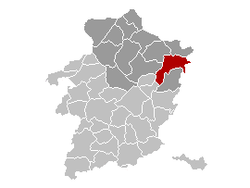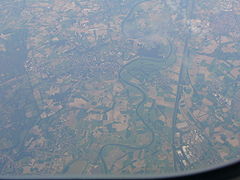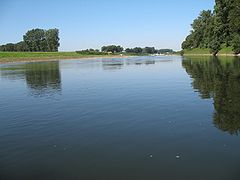- Maaseik
-
Maaseik 
Flag
Coat of armsLocation in Belgium Coordinates: 51°06′N 05°48′E / 51.1°N 5.8°E Country Belgium Region Flemish Region Community Flemish Community Province Limburg Arrondissement Maaseik Government – Mayor Jan Creemers (CD&V) – Governing party/ies CD&V, VLD Area – Total 76.91 km2 (29.7 sq mi) Population (1 January 2010)[1] – Total 24,570 – Density 319.5/km2 (827.4/sq mi) Postal codes 3680 Area codes 089 Website www.maaseik.be Maaseik is a municipality located in the Belgian province of Limburg. The city is located on the river Meuse (Maas), bordering the Netherlands. The Maaseik municipality includes the town of Maaseik and the villages of Neeroeteren and Opoeteren. The town of Maaseik includes the hamlets of Aldeneik, Heppeneert, Wurfeld, 't Ven and Gremelslo.
Contents
History
Religious origins
As its name would suggest, Aldeneik is older than Maaseik. Although there are a lot of toponyms referring to the many oaks, the word eyck is similar to the German word 'ecke', which means 'corner'. Old bend may be linked to the fact that historically, the Meuse formed a bend around the village. Throughout the whole Meuse region, the course of the Meuse has always shifted slowly. This happened also in Heppeneert, a hamlet just south of Maaseik. The old course of the Meuse is still clearly seen there.
Aldeneik was established by Adelard, a local Frankish lord, around 700 AD, as a Benedictine monastery. His two daughters, Herlindis and Relindis, both became abbesses of the monastery and eventually became saints. The religious center of Aldeneik soon became the focal point of a small community.
The monastery suffered heavy destruction by the Normans in the 9th century. Around 950, emperor Otto I gave the monastery to the Bishop of Liège, who delegated the administrative tasks to a local chapter of canons.
Middle Ages
Maaseik, Nieuw-Eycke ('new oak'), is founded out of Aldeneik, around 1000. It was lying near the Roman road between Maastricht and Nijmegen and safe above the valley of the Meuse. Besides, it bordered the County of Loon in the north; that's why this village got its City charter in 1244. The village began to grow. It became one of the most important trading places of the Meuse region.
Typical are the four main streets beginning on the square market place. On this market place stands a statue of the famous painters Hubert and Jan van Eyck, who would be born in Maaseik (1390). On the market stands also the oldest private pharmacy of Belgium. Also typical is the rectangle shape of the walls. In the westside of the city was built a castle against the wall.
Those walls have been dismantled in 1467, when Charles the Bold attacked the Prince-Bishopric of Liège and destructed many cities in the region. Maaseik was also besieged in 1672, by Louis XIV. The city burned in 1650 and 1684; the last one destroyed 1/3 of the entire city, included the historic center. After that the Maaseikenaars built stone houses instead of wooden ones. During the iconoclasm, Maaseik became almost independent, but Gerard van Groesbeek could calm down the people.
16th century until now
In the 16th and 17th century the economy reached its highlight, thanks to its advantageous location between Liège and the sea. Its commercial activity remained strong until the second half of the 17th century, when the regional power of Liège started to fade. During all that time, Maaseik was still a dependence of the chapter of canons in Aldeneik. Just before the French Revolution, no less than six religious orders were still present in the city.
The walls were rebuilt in the 16th century and strengthened by Vauban in the following century. After the French retreat in 1815, however, the military installations were gradually taken down. Only in the south the embankement is still remaining. Names of the old city gates (e.g., Bospoort, Maaspoort) remind either to the walls. In 2007, remainings of a tower have been found by digging a parking garage in the underground. This tower was part of the castle.
The Industrial Revolution of the 19th century seems to have bypassed Maaseik. It last its importance and did not grow, but thanks of that maney houses out the Renaissance are still existing. Though, there had been constructed a railroad to As. This road has been removed around 1950; it is now part of the famous cicle network in Belgian Limburg.
Before World War I, the bridge over the Meuse, the Pater Sangersbrug, was built, connecting Maaseik directly with the Netherlands and improving opportunities for trade. This bridge was destroyed several times during both World Wars. The present bridge was built in 1951 and replaced an American bridge from 1944. Today, the city is mostly a regional centre offering shopping, educational, and medical services to the surrounding communities.
Sights
- The main market square with the city’s most famous sons, Jan and Hubert van Eyck. The market place is also surrounded by medieval houses.
- In the nearby Franciscan cloister, a permanent exhibition about the brothers van Eyck and a scale model of the city as it was in 1672 can be seen.
- The Sint-Catharinakerk houses
- The Museactron, another museum, which includes a regional archaeological museum, a pharmacy museum and a bakery museum. The museum holds the oldest Gospel Book of the Benelux, the Codex Eyckensis, which dates from the 7th or 8th century. In 2008 an exhibit was held containing seventeen original soldiers of the Terracotta Army of the Chinese city of Xian.
- Twelve of the original sixteen watermills around the city are in very good shape and still make flour or saw wood.
- The Sint-Catharinakerk
Notable people
- Saint Herlindis, abbess and saint (d. 745)
- Saint Relindis, sister of Herlindis, abbess and saint (d. 750)
- Jan and Hubert van Eyck, painters, thought to have been born in Maaseik (c. 1385-1441 and c. 1366-1426, respectively)
- Vital Borkelmans, football fullback (b. 1963)
- Kristof Vliegen, tennis player (b. 1982)
- Mohamed Ouali (Martial Artist - 5x world champion Thai-kickboxing) B. 1971
Twin cities
 Germany: Wegberg
Germany: Wegberg Netherlands: Echt-Susteren, across the Meuse River
Netherlands: Echt-Susteren, across the Meuse River
See also
- Islamic dress controversy in Europe
References
- ^ Population per municipality on 1 January 2010 (XLS; 221 KB)
External links
- Official website - Only available in Dutch
Hasselt As · Beringen · Diepenbeek · Genk · Gingelom · Halen · Ham · Hasselt · Herk-de-Stad · Heusden-Zolder · Leopoldsburg · Lummen · Nieuwerkerken · Opglabbeek · Sint-Truiden · Tessenderlo · Zonhoven · Zutendaal
Maaseik Bocholt · Bree · Dilsen-Stokkem · Hamont-Achel · Hechtel-Eksel · Houthalen-Helchteren · Kinrooi · Lommel · Maaseik · Meeuwen-Gruitrode · Neerpelt · Overpelt · PeerTongeren Categories:- Municipalities of Limburg (Belgium)
- Populated places in Belgium
- Belgium–Netherlands border crossings
Wikimedia Foundation. 2010.





